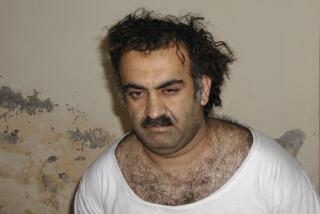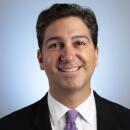Osama bin Laden’s surrender wasn’t a likely outcome in raid, officials say
- Share via
Reporting from Washington — U.S. commandos who attacked Osama bin Laden’s compound were operating under rules of engagement that all but assured the Al Qaeda leader would be killed, officials have acknowledged, backing away from an initial account that Bin Laden was armed and used a woman as a shield.
After saying Monday that the American operatives who raided the Pakistani compound had orders to capture Bin Laden if he gave himself up, U.S. officials Tuesday added an important qualifier: The assault force was told to accept a surrender only if it could be sure he didn’t have a bomb hidden under his clothing and posed no other danger.
Bin Laden could have surrendered only “if he did not pose any type of threat whatsoever,” White House counter-terrorism chief John Brennan said on Fox television, and if U.S. troops “were confident of that in terms of his not having an IED [improvised explosives device] on his body, his not having some type of hidden weapon or whatever.”
Added a senior congressional aide briefed on the rules of engagement: “He would have had to have been naked for them to allow him to surrender.”
Once troops exchanged fire with Bin Laden allies living in the compound — three men and a woman were killed in addition to the Al Qaeda leader — the chances of a surrender were almost nil, experts say.
The surrender issue was one of several on which administration officials shifted ground.
At the White House, spokesman Jay Carney read a Pentagon “narrative” of the tense minutes at the compound in the city of Abbottabad that he said was intended to correct information that had been released “in great haste” by Brennan the day before. Brennan had said Bin Laden was armed, “engaged in a firefight” with U.S. forces and shielded himself behind a woman.
“In the room with Bin Laden, a woman — Bin Laden’s wife — rushed the U.S. assaulter and was shot in the leg but not killed,” Carney said. “Bin Laden was then shot and killed. He was not armed.”
CIA Director Leon E. Panetta said in an interview on PBS television Tuesday that he did not believe Bin Laden had a chance to speak before he was shot in the face and killed.
“To be frank, I don’t think he had a lot of time to say anything,” Panetta said.
Nonetheless, officials strongly defended the decision to shoot. “The right of self-defense is never denied,” said a special forces officer interviewed by telephone who was not authorized to speak publicly.
“If anyone feels in any way that there is a hostile threat in a case like this — it can be a movement, or a failure to follow commands — deadly force will be authorized. It’s a judgment call,” the officer said. “And these assaulters are some of the finest, most highly trained in discriminate shooting. They train for hostage rescue.”
The CIA has had grim experience with concealed suicide vests: In December 2009, a Jordanian doctor who the CIA believed was its agent blew himself up with a vest, killing seven CIA employees and contractors who had come to greet him at a base in Khowst, Afghanistan.
Yet if Bin Laden had been taken alive, it would have posed myriad complications.
The U.S. probably would have faced questions about the legality of having snatched a prisoner from a sovereign country without that country’s permission, and whether to treat him as an enemy combatant or pursue a criminal prosecution.
Panetta told Congress last month that Bin Laden probably would have been taken first to Bagram Air Base in Afghanistan and then the prison at Guantanamo Bay, Cuba, an uncomfortable chain of events for an administration that promised to close Guantanamo. And any legal proceeding, whether criminal or military, would have afforded the world’s most famous terrorist leader a global platform.
Carney also said officials were still mulling over the release of a gruesome photograph of a dead Bin Laden. Officials understand that some people will not believe the Al Qaeda leader is dead without seeing the photograph, but they are concerned about the “sensitivity” of the image, which could offend or inflame parts of the Muslim world.
He added that the White House stood by its claim Monday that Bin Laden had resisted capture, but said that “resistance does not require a firearm.”
Asked how the White House had gotten the initial story wrong, Carney said officials had been rushing to release information about a complex, fast-moving operation.
“We provided a great deal of information in great haste in order to inform you, and through you the American public, about the operation and how it transpired,” he said. “And obviously some of the information came in piece by piece and is being reviewed and updated and elaborated on.”
One of the other people killed in the raid is believed to be Bin Laden’s son, and the two other dead men were described as brothers who are the listed owners of the compound, one of whom was the Al Qaeda courier who unwittingly led the CIA to Bin Laden. The dead woman is the wife of the courier, U.S. officials said.
Officials said they left the other residents, mostly women and children, at the compound.
Obama’s decision to order a surgical raid continued to draw praise on Capitol Hill from both Republicans and Democrats.
“They could have sent a Predator with Hellfire missiles and killed everyone in the place. They didn’t do it,” said Sen. Dianne Feinstein (D-Calif.), who is chairwoman of the Senate Intelligence Committee. “It was a very gutsy mission.”
U.S. officials also disclosed new details of Bin Laden’s activities while hiding in his Abbottabad compound. The Al Qaeda leader no longer ran day-to-day operations of the terrorist network he had founded. But he continued to secretly send strategic guidance to affiliate groups scattered around the globe, the officials said.
Early this year, for example, Bin Laden dispatched written messages by courier to Al Qaeda franchises in Iraq, Yemen and Algeria, said three current and former U.S. officials who are familiar with the intelligence and who spoke on condition of anonymity.
“Bin Laden’s guidance was, ‘Remember, Americans are the primary enemy now. Don’t get bogged down in local fights,’ ” one official said.
He said the messages probably were designed to silence restive factions within the affiliates that wanted to join forces with local insurgencies against governments.
The official said Bin Laden appeared particularly worried about attacks launched by an Algerian-based group, Al Qaeda in the Islamic Maghreb, in North Africa.
Officials said the messages suggest that Bin Laden was concerned that without his direction, the far-flung franchises could lose their common purpose against the West and therefore diminish Al Qaeda’s strategic power.
Peter Nicholas in the Washington bureau contributed to this report.
More to Read
Sign up for Essential California
The most important California stories and recommendations in your inbox every morning.
You may occasionally receive promotional content from the Los Angeles Times.












